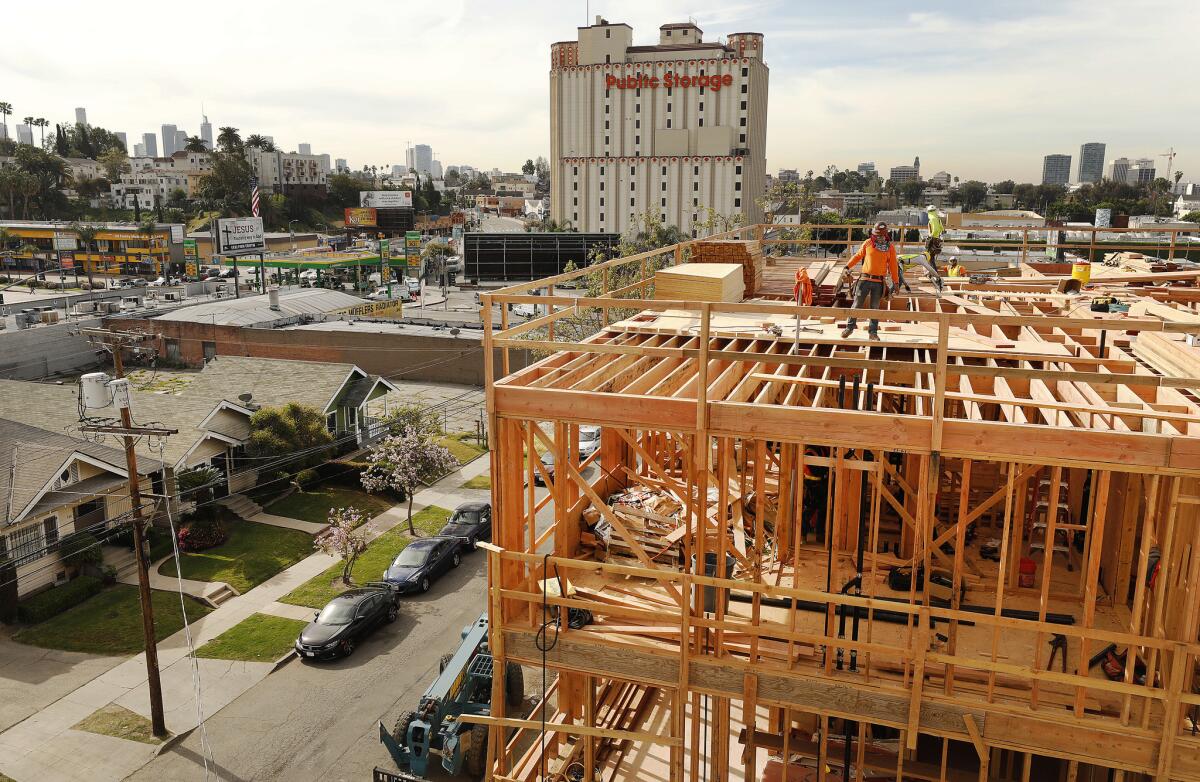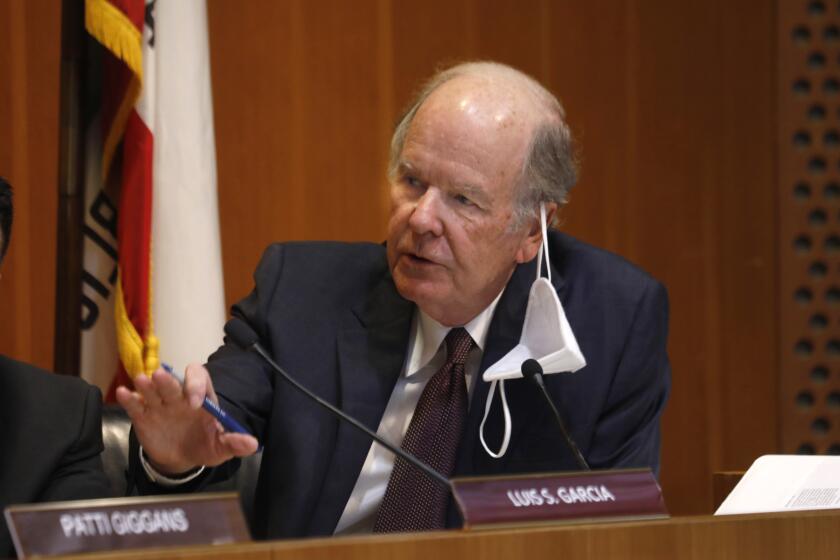How close is L.A. to building 10,000 houses for homeless people? Here’s a breakdown

- Share via
In 2016, Los Angeles voters approved a $1.2-billion bond measure to help fund housing for homeless people, with a goal of 10,000 new units in a decade.
Now, after hustling to get as many housing projects started as soon as possible, city officials are coming to the end of the money available through Proposition HHH, and it’s not certain that promise will be kept.
The city has committed two-thirds of the bond to secure a little more than half the units the measure was intended to subsidize.
The new challenge will be figuring out how to stretch the remaining funds to make up the difference. It’s far from a sure thing.
In the coming weeks, city housing officials will review bids far exceeding the $338 million remaining in Proposition HHH. To get close to the 10,000-unit goal, they will need to tap other sources of funding from the state and employ new ideas for building housing less expensively.
It’s still too soon to see any effect from Proposition HHH on the city’s homeless crisis.

Construction on several housing projects has started, and the pace is picking up. But the first units won’t be ready until December. The last of the currently funded projects is scheduled for completion in December 2022.
But after months of alarm over rising costs, advocates for homeless people are becoming more optimistic.
“When you look at this holistically, we’re actually in a relatively solid position,” said Tommy Newman, director of public affairs for United Way of Greater Los Angeles, which backed HHH and has monitored its progress since 2016. “Now we have to be creative in how we combine the funds that still remain, new sources of funding that don’t exist yet and the innovations that are being tossed in around housing.”
So far, the L.A. City Council has approved $809 million in subsidies for 79 projects. Plans for those projects call for 4,120 units of housing with supportive services.
To produce 10,000 units by 2026, the city would have to use the remaining HHH funds to subsidize 2,880 more units of supportive housing, bringing L.A. within reach of the bond measure’s original target of subsidizing 7,000 units. The city also would have to keep securing enough money from other sources to subsidize an additional 300 supportive units every year, for a total of about 3,000 units over a decade.
Progress has fallen behind on both fronts.
Since Proposition HHH passed, construction costs for supportive housing have climbed to an average of more than $550,000 per unit, and federal tax credits — the primary source of funding for supportive housing — lost value because of the recent federal tax cut.
City housing officials have filled that gap with larger HHH subsidies, averaging more than $151,000 for the units overall. But Proposition HHH also provided for up to 20% of the bond to be spent on an unspecified number of affordable housing units, which are not reserved for homeless people and do not count toward the city’s housing goal of 10,000 units. So far, 1,268 of those have been funded.
That leaves only about $117,000 in subsidies for each of the 2,880 supportive units that remain to be funded — or less if more affordable housing units are approved.
Meanwhile, to speed up the production of housing, housing officials have shifted HHH funds to some of the 300 units that the city initially intended to build each year without HHH subsidies. Officials reported last month that only 40 new supportive units that will be built without HHH money are currently planned.
“[Developers have] been focusing on HHH because that’s the path of least resistance” compared to other forms of financing, said Rushmore Cervantes, general manager of the city’s Housing and Community Investment Department.
Officials are now making several adjustments to stretch the remaining $338 million from the bond measure.
First, the housing department, which initially allowed HHH subsidies as high as $220,000 per unit, has cut the maximum to $140,000. That won’t reduce construction costs, but will require developers to rely more on other sources for money.
Second, reacting to pressure from the citizens committee appointed to oversee HHH spending, the City Council in January set aside $120 million from the $338 million for Mayor Eric Garcetti to explore faster and cheaper methods for building homeless housing.
The mayor’s goal is to produce 1,000 new units with that money. This month, he is expected to solicit proposals designed to attract developers that use methods such as modular construction and financing plans that don’t rely on cumbersome tax-credit financing.
Third, city housing officials are pressuring developers to rely more on other funding sources. They are reviewing a new batch of bids for $204 million. That will leave only $14 million unallocated after the mayor’s cut is taken. For the first time since the inception of the HHH program, they must pick winners and losers rather than simply approving a project as qualified. With developers vying for $369 million in subsidies, they are rating applicants based on how much money they can draw from other sources.
Cervantes said it won’t be known how many units the remaining funds will produce until the housing staff has reviewed and scored all the proposals, probably in June. But he said he hopes the projects, along with the mayor’s program, would bring the total close to the required 7,000 units.
That would still leave the city making up lost ground in building 3,000 units with non-HHH funding sources.
Now that HHH money is running out, developers will have to go back to the traditional method, Cervantes said, primarily through tax credits. He foresees the current shortfall being made up in the years ahead by additional sources that were not available in 2016.
Among the possible sources is the “No Place Like Home” program, which the state Legislature approved in 2016 and voters reaffirmed with a 2018 ballot initiative. It allows up to $2 billion to be diverted from the Mental Health Services Act for housing for homeless people. Of the $2 billion, Los Angeles County is expected to receive about $700 million starting this summer.
Another source is Proposition 1, a housing bond approved by California voters in 2018 to create a $1.5 billion multifamily housing program. There’s also a new statewide tax on real estate transfers that is expected to generate $250 million a year that will largely be distributed to local governments for housing and homelessness programs.
In Los Angeles, specifically, the city’s new fee on development projects kicks in this summer and is expected to deliver $100 million annually. Cervantes is confident some of it will be available for homeless housing.
“Because the goal is out there to get 10,000 units,” he said, “there is going to be political support to utilize some of those dollars potentially for supportive housing.”
Ultimately, the question of whether the city reaches the promised 10,000 units may be subject to disputed interpretations of the measure’s intent.
The housing department reports that more than 1,000 units that were in the pipeline before HHH and will be completed during the decade without HHH funding are covered by the pledge.
Newman, the United Way watchdog, doesn’t think so.
“The cleanest way to look at this is, when is the city committing those funds?” Newman said.
Regardless, Newman and some early HHH critics are seeing success that transcends numbers.
Miguel Santana, the former city administrative officer and HHH oversight committee chairman who has at times been a sharp critic of the housing department’s achievements, expects Garcetti’s innovation challenge to have an effect on homelessness well beyond HHH.
“HHH has been a huge success because we are on our way to having 7,000 units that wouldn’t have been available except for HHH,” Santana said. “We still have an opportunity to expand the model so we’re in a much better place in the future as we build enough housing for the next 7,000 people.”
Newman sees an unexpected victory.
“There was a lot of fear we would not be able to build this housing because everybody was going to fight it,” he said. “With 4,200 units in development, we can say we can clearly build this housing in every council district.”
More to Read
Sign up for Essential California
The most important California stories and recommendations in your inbox every morning.
You may occasionally receive promotional content from the Los Angeles Times.














